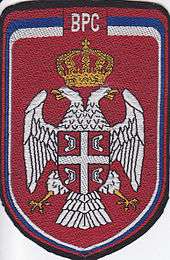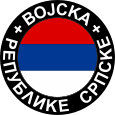Army of Republika Srpska
| Army of Republika Srpska Војска Републике Српске (ВРС) Vojska Republike Srpske (VRS) | |
|---|---|
|
Emblem of the Army of Republika Srpska | |
| Size | 80,000 soldiers (during the Bosnian War)[1]:130[2] |
| Garrison/HQ | Banja Luka, Republika Srpska |
| Anniversaries | 1992 (founded), 2001 (re-organisation) |
| Engagements |
Bosnian War Croatian War of Independence |
| Disbanded | 2006 |
| Commanders | |
| Notable commanders | Ratko Mladić (1992–1996)[3] |
The Army of Republika Srpska (Serbian: Војска Републике Српске (ВРС); Serbian, Bosnian, Croatian Vojska Republike Srpske (VRS)), also referred to as the Bosnian Serb Army, was the military of the Republika Srpska, an area which was previously the "Serbian Republic of Bosnia and Herzegovina".
In 2003 the army began to integrate into the Armed Forces of Bosnia and Herzegovina. In 2005 a fully integrated unit of Serbs, Bosniaks, and Croats was deployed to augment the US-led coalition forces in Iraq.[4] On 6 June 2006, it was fully integrated into the Armed Forces of Bosnia and Herzegovina controlled by the Ministry of Defence of Bosnia and Herzegovina.[5][1]
History

The Army of the Republika Srpska (VRS) was founded on 12 May 1992 from the remnants of the Yugoslav People's Army (JNA) of the former Socialist Federal Republic of Yugoslavia from which Bosnia and Herzegovina had seceded the same year. When the Bosnian War erupted, the JNA formally discharged 80,000 Bosnian Serb troops. These troops, who were allowed to keep their heavy weapons, formed the backbone of the newly formed Army of the Republika Srpska.[6] Aside from being made up almost entirely of Serb Orthodox officers and recruits from Bosnia and Herzegovina, the VRS also utilized the services of approximately 4,000 foreign Orthodox Christian volunteers to participate in combat operations during the Bosnian War. 1,000-1,500 of these came from Russia, and Bulgaria,[7] with 700 volunteers originating from Russia specifically.[8] 100 Greeks also volunteered to fight on the side of the Bosnian Serbs, forming the Greek Volunteer Guard which allegedly participated in the Srebrenica massacre.[9] The Army of Republika Srpska were a main belligerent in the Bosnian War, and were responsible for thousands of deaths, including the massacre of around 8,000 Bosniak men and boys in Srebenica in July 1995.[10]
The military leader of the VRS was General Ratko Mladić, who is now indicted at the International Criminal Tribunal for the Former Yugoslavia (ICTY) for genocide, as are other high-ranking Serb officers. Mladić was arrested in Serbia on 26 May 2011.
Special units
- Panthers Guard Special Brigade (Специјална бригада Гарда Пантери), East-Bosnian Corps
- Wolves from the Drina, or Drina Wolves (Вукови са Дрине), Drina Corps
- Special Unit "MANDO" (Специјална Јединица "МАНДО"), East-Bosnian Corps
- Special Unit "OSMACI" (Специјална Јединица "ОСМАЦИ"), Drina Corps
- Serb Guard Ilidža (Српска Гарда Илиџа), Sarajevo-Romanija Corps
- White Wolves (Бели Вукови)
Organization
1993
- 1st Krajina Corps – Banja Luka
- 2nd Krajina Corps – Drvar
- 3rd Corps – Bijeljina
- East Bosnia Corps – Han Pijesak
- Herzegovina Corps – Bileća
1995
- 1st Krajina Corps – Banja Luka
- 2nd Krajina Corps – Drvar
- East Bosnia Corps – Bijeljina
- Sarajevo-Romanija Corps – Pale
- Drina Corps – Han Pijesak
- Herzegovina Corps – Bileća
2001
- 1st Corps – Banja Luka
- 3rd Corps – Bijeljina
- 5th Corps – Sokolac
- 7th Corps – Bileća
Equipment
Tanks and armoured vehicles
Towed artillery
Self-propelled artillery
MLRS
ATGW
Antitank guns
Anti-aircraft guns
MANPADs and SAMs
Infantry weapons
Pistols
Assault Rifles
Battle Rifles
Sub Machineguns
Machineguns
Sniper Rifles
Anti-Tank Weapons
Republika Srpska Air Force
Formerly known as Ratno Vazduhoplovstva i Protiv Vazdušna Odbrana Vojska Republike Srpske or RV i PVO RS. Beginning on 1 June 2004, the Republika Srpska Air Force was officially called, Prvi Puk Vazduhoplovstva i Protiv Vazdušna Odbrana Vojske Republike Srpske, also known as 1st Aviation Regiment and Air Defence Force of the Republic of Srpska's Army.
References
- 1 2 Ramet, Sabrina, ed. (2010). Central and Southeast European Politics since 1989. Cambridge University Press. p. 324. ISBN 9780521888103. Retrieved 31 March 2016.
- ↑ Jonathan S. Landay (15 August 1994). "UN Says Lifting Bosnia Embargo May Hurt Muslims, Help Serbs". The Christian Science Monitor. Retrieved 4 March 2013.
- ↑ "THE INTERNATIONAL CRIMINAL TRIBUNAL FOR THE FORMER YUGOSLAVIA – Case No. IT-95-5/18-I". UN – ICTY. 2007. Archived from the original on 19 September 2007. Retrieved 2007-09-26.
On 12 May 1992, Ratko MLADIC was appointed Commander of the Main Staff of the VRS, a position he held until at least 22 December 1996. On 24 June 1994, Ratko MLADIC was promoted to the rank of General Colonel.
- ↑ Nedim Dervisbegovic (2005-06-02). "Bosnia's first unified army platoon deployed to Iraq". The San Diego Union-Tribune. Archived from the original on 15 October 2007. Retrieved 2007-09-26.
- ↑ Gaub, Florence (2011). Military Integration after Civil Wars: Multiethnic Armies, Identity and Post Conflict Reconstruction. Canada: Routledge. ISBN 9780203841051. Retrieved 31 March 2016.
- ↑ John Kifner (27 January 1994). "Yugoslav Army Reported Fighting In Bosnia to Help Serbian Forces". The New York Times. Retrieved 4 March 2013.
- ↑ Innes 2006, p. 157
- ↑ Thomas 2006, p. 13
- ↑ Helena Smith (5 January 2003). "Greece faces shame of role in Serb massacre". The Guardian. Retrieved 4 March 2013.
- ↑ ICTY 30 June 2006
Books
- Innes, Michael A. (2006). Bosnian Security after Dayton: New Perspectives. Routledge. Retrieved 4 March 2013.
- Ramet, Sabrina P. (2010). Central and Southeast European Politics Since 1989. Cambridge University Press. Retrieved 4 March 2013.
- Thomas, Nigel (2006). The Yugoslav Wars (2): Bosnia, Kosovo and Macedonia 1992–2001. Osprey Publishing. Retrieved 4 March 2013.


